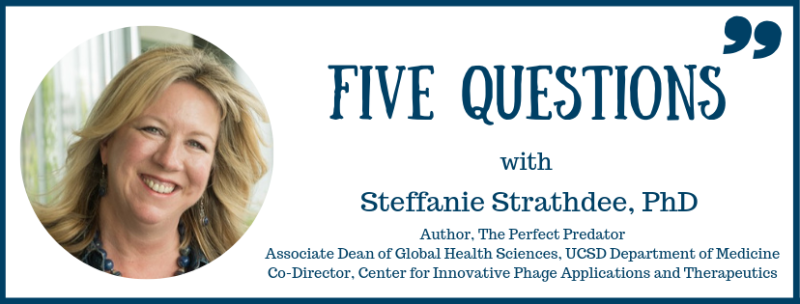Expert Spotlight: 5 Questions with The Perfect Predator
We were excited to learn more about this new book, The Perfect Predator - A Scientist’s Race to Save Her Husband from a Deadly Superbug by Steffanie Strathdee and Tom Patterson, both renowned scientists at the University of California, San Diego. We first became aware of Dr. Strathdee though Twitter (@chngin_the_wrld) where she routinely highlights global health issues, including antibiotic resistance. So, when we heard about their first-hand experience in fighting a deadly superbug, we knew we had to interview Steffanie and learn more!
1. First, congrats on finishing your memoir, The Perfect Predator - A Scientist’s Race to Save Her Husband from a Deadly Superbug! We’re glad this story has a happy ending for you and your husband, Tom. It’s an understatement to say that A LOT has happened in the last few years for Tom and you. Can you give our readers an overview of how this book came to be?
When my husband Tom and I were on vacation in Egypt, he had an attack of what first seemed like food poisoning but it wasn’t. A gallstone had lodged itself in his bile duct, generating an abscess in his abdomen the size of a small football. After we were medevacked to a hospital in Germany, we found out that inside this abscess lurked something much worse: a superbug that had become resistant to all antibiotics. Our book is about the story of how a global village of doctors and researchers from around the world saved his life with a hundred year old forgotten cure—phage therapy—that shows promise as a weapon to tackle the global superbug crisis.
2. It’s terrifying when we read about stories like yours where none of the 18 antibiotics, including the last-resort antibiotic, colistin, could not kill the strain of the bacteria infecting Tom. You stumbled upon research on a little known practice in medicine called phage therapy. Tell us more about your discovery and how you “saved your husband’s life with sewage.”
Phage therapy isn’t actually new. Bacteriophages (phages) were discovered over 100 years ago and have been used to treat bacterial infections in people and animals ever since, especially in the former Soviet Union and Poland. But phage therapy was abandoned in the West when penicillin started to be mass produced. And the fact that phages were discovered by a researcher with no formal training and phage therapy was embraced by Russia didn’t help matters. In fact, this geopolitical bias put a cloud over phage therapy for decades. We’re trying to un-do that.
3. You’ve been busy! In addition to the book you’ve launched the Center for Innovative Phage Applications and Therapeutics (IPATH) at the UC San Diego School of Medicine. It’s the first center in North America that uses phage therapy to combat superbug infections. Can you tell our readers more about the center and what you hope to achieve with it?
My colleagues and I launched IPATH because we realized that if phage therapy stands a chance at becoming an approved treatment for bacterial infections by the FDA, it needs to undergo rigorous clinical trials. IPATH will continue to help patients with pan-resistant superbug infections who are seeking phage therapy, but our long term goal is to launch clinical trials to determine if phage therapy proves efficacious.
4. The more the general public, policymakers, and others know and hear about antibiotic resistance the better. What do you think we need to do to wake people up and really start working to help combat this public health threat?
After Tom was cured of his superbug infection with phage therapy, his story went viral, but in a good way. It was clear from talking to reporters that there is no ‘public face’ for superbug infections like there is for cancer, HIV or Parkinson’s. Tom was asked if he was willing to be that face, and he didn’t hesitate. Through our story and book, we’re hoping we can educate people about superbugs and phage therapy, and make it easier for other people to get this treatment. We know we were very fortunate to have had the help we did, whereas the 1.5 million people who are estimated to die of superbug infections each year don’t have the same kinds of resources we did. We hope our story is a wake up call.
5. It’s so cool that you were named one of TIME magazine’s 50 Most Influential People in Health Care for 2018! At what point in your life did you decide you wanted to become a scientist and why?
I’ve always been a curious person and loved science. But when my PhD advisor and my best friend died of AIDS in the early 1990s within a year of one another, I dedicated my career to putting myself out of a job by focusing on HIV prevention. Until recently, I always considered viruses the enemy, but with phage therapy, the enemy of my enemy is my friend.


